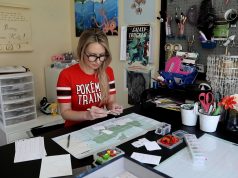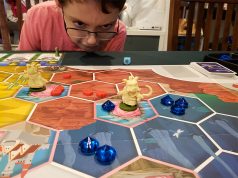Even though 2020 is firmly behind us, the specter of those dark times remains. Much like the novel’s ending of Lord of the Rings, the world comes back from the brink, but it’s changed. The needs of social distancing ask us to question what, ultimately, we need from every single interaction we have in real life. Do we just need to trade stuff in the physical world, or is the personal space we share make for a more personal feeling? We must take stock and dig deep to search within ourselves what it is we ask of social interactions.
“Whoa there Shamma!” you’re probably saying. You probably came here just to find out if Castle TriCon, a new virtual gaming convention, is cool. Well, the short answer is “yes, kinda”, but the format of the entire experience has made me see social interactions in real life rather differently. Let me break it down.
After logging in to Castle TriCon, you appear as an avatar in a virtual world with a resolution just a couple polygons above the visual aesthetic of Minecraft. Ok so far. To get your self-presentation ready, there are plenty of outfits for your avatar, even including a hot dog mascot. In addition, you can find additional outfits by exploring the world. This world functions like a small theme park with “teleport clouds” that move you to different themed worlds. Different publishers have also set up in different worlds, so it helps to distinguish them for their demos/videos.
To give a better idea of what this is, imagine board game publishers wanted to host Gen Con inside Minecraft with a manufactured theme park inside. You’re going to get the big signage and the various toys to draw your attention, but the real way the world changes your perception of the “real” is in how you interact with other humans. Each time your avatar moves close to interaction zones, something happens.
With a video interaction zone, as soon as you step into the space, a large sign near you becomes a video screen playing some marketing video similar to a Kickstarter short promoting a specific game you’re near. This is jarring and definitely makes you want to take the long way around when walking (really running) around to make sure you don’t accidentally trigger them.
The more personal interaction zones are the “in-person chat” zones. To get the best experience, since this meant to be a more intimate interaction, it’s best to have a video camera/webcam. When you step into these zones, your camera turns on, and you’re immediately in a video voice call with anyone else in the same zone. For the press day I attended, this was mostly marketing support team members from CGE. They were extremely helpful, but it does feel awkward to be playing a virtual reality game and then suddenly be shunted into the real world talking to a person on a PC in their bedroom. It’s incredibly intimate very quickly, and I wasn’t expecting it. The reason we have small-talk and public via private spaces is to articulate the non-verbal trepidation that comes with personal interaction. The experience of meeting someone in a video chat this way is more personal than it would be on a convention show floor.
Now, as for the games, there wasn’t a ton to look at and everything being demoed has a video somewhere already on YouTube. I figured I’d try a demo of Under Falling Skies just to see what it was like. I asked a team member in one of the in-person chat zones about the game and he walked me over to a virtual table with an Under Falling Skies box on the table. You click on the box and you’re taken into another interface, one which is more similar to a stripped-down Tabletopia.
In this new experience, the presenter demoing the game is just a voice moving game pieces with an invisible hand. You, as an observer, can watch or tell the presenter what you want to do. In the case of Under Falling Skies, it’s dice placement so you have to ask with enough descriptors to let them know where you want dice placed without having any kind of cursor or “hand” to point with. The same is true for the presenter. They can’t point out things as they’re teaching the game which makes it incredibly difficult to follow a demo for a game you know nothing about.
All in all, I understand this is a novel experience, and it certainly has a lot of maturing to do. The real problem is that it’s trying too hard to replicate what we’re used to in the real world. Meanwhile, it makes some amateur mistakes with some user interface patterns already established by the “mature” platforms of Tabletopia and Tabletop Simulator. With avatars and virtual spaces, I find that the video chat is not necessary. There are other graphical metaphors that can serve the same purpose with more efficiency. Why not just voice chat with speech bubbles to indicate when someone is speaking? This is closer to Discord and players should already be very familiar with that if they’ve played online.
The other issue was just how much the experience felt like an amusement park. If I’m there to socialize and play games, it seems like the focus should be there instead of gamifying the experience as a whole. As someone who has keenly felt the loss of socialization from the pandemic, I was looking more for the virtual space to escort me into personal connections. I’m not sure that was accomplished. It’s a praiseworthy effort, but it still needs work.






















